What I love best about our new Math Literacy course is that I really feel like we designed it to have heart and soul, and I can’t say that about many other math courses. Let me give you some background on how and why we did it.
Why?
Our redesign at Parkland College started as an investigation into our poor retention rates in College Algebra and Precalculus. One aspect we wanted to address was that students seemed unprepared for these classes. We were looking at our Intermediate Algebra course to see what could be done to better prepare students for the rigor and pace of College Algebra.
As we started thinking about what topics to add to Intermediate Algebra and ways to pick up the pace, we became somewhat uncomfortable about how this might affect the students in Intermediate Algebra who are NOT headed to College Algebra. After all, Intermediate Algebra is also the prerequisite for our courses that students take if they just need a general education course: General Education Mathematics (our Liberal Arts Math course) and Intro to Statistics. The extra material and speed in Intermediate Algebra, intended specifically for students in STEM fields, might cause more of our non-STEM students to be unsuccessful. In fact, those non-STEM students are the majority. When we looked at the numbers, we realized that only 25% of our Intermediate Algebra students need College Algebra! That didn’t seem fair, considering the changes we wanted to make.
Right around this time, the idea of two developmental math tracks was gaining momentum in the Illinois Mathematics Association of Community Colleges (IMACC). Hey, we thought, this just might be the answer to our problems—if we split the non-STEM students off into another course, we can do everything we need to in Intermediate Algebra without feeling guilty.
Then we started thinking, hey—what if we took this opportunity to not only split the non-STEM students off, but to give them a course that is specifically designed for their needs? Their general education math courses are going to require application and written analysis, two things that are covered in Intermediate Algebra, but not nearly to the same extent as symbolic algebra. What if we designed a course that de-emphasized symbolic algebra, and instead focused on interesting parts of math that non-STEM students need? We had our skeptics—wouldn’t this just be watered-down course designed to help students pass? No! This became an important foundation of our plan: it can’t be easier, just different. What if we built a whole course around topics with real-life applications and analysis of results? What would that look like? Then we could also work in time to discuss success skills for both school and life, like persistence in the face of a difficult problem. And Mathematical Literacy was born…
How?
To design the course, we used the curriculum development principles of Dee Fink (see Fink, L. Dee, 2003, Creating Significant Learning Experiences: An Integrated Approach to Designing College Courses). This is a backwards-design approach, in which the first thing you do is really think about what you want your students to be able to do when they finish the course, and what you want them to still remember in five years.
We began our course design with two main principles:
- If we can’t find a meaningful application, the topic doesn’t need to be there
- Students need to understand, not memorize, if we want them to really use this stuff
Eventually, these evolved into our underlying course philosophy: Learning about real math that has real applications, in an investigative format that supports students understanding.
So what does that look like? Following Fink’s approach, we started by defining our learning goals for the course in six categories: Foundational Knowledge, Application, Integration, Learning How to Learn, Human Dimension, and Caring. When students leave this course, what do we want them to be able to do?
We started with some Foundational Knowledge and Applications from algebra. We went through Beginning and Intermediate Algebra, keeping topics that had useful real-life applications, and throwing out the rest. We also asked ourselves what students might need in their gen-ed courses or their lives, skills that would make them more informed, productive people. We ended up with a lot of really interesting algebra applications, and added in some probability, data analysis, and technology skills.
For Integration, we wanted students to recognize the connections between the problems they are trying to solve and four threads: Number sense, Functions and modeling, Algebraic reasoning, and Real-world applications.
In terms of Learning How to Learn, students should be able to take initiative for their own progress in the course, make a study plan, manage their time outside of class, and learn how to work on difficult problems without getting frustrated and giving up.
For Human Dimension and Caring, we wanted students to see the importance of mathematics in society and culture, work together in teams, be engaged and interested, and value the use of mathematics as an analysis tool.
Next, how will you know students can do these things? How will you assess them? We determined that the kinds of things we want students to be able to do aren’t demonstrated on a traditional math exam. Assessing these things requires open-ended written responses, projects, etc.
Then we addressed pedagogy. If we need to assess with written explanations and projects, what types of learning activities will prepare students for that? We decided this could NOT be a lecture-based class. Students must work through the material, making sense of it instead of memorizing procedures. Group investigations seemed like the best way to do this, so students could work through the material, discuss it, get help in class, and make sense of the concepts. Any follow-up skill practice could happen outside of class, after they worked on the “hard stuff” in class.
We then followed Fink’s approach to outline course topics, how exactly the class would run on a typical day and over the course of a unit, and other details.
From my perspective as the instructor, this has made the class very different, very fun and intellectually stimulating, and very exhausting. I get to walk around and talk to my students. I have to be at the top of my game every day, because I have to think on my feet as students ask unexpected questions and pose tangential conjectures. I have so many conversations in which I say, “Well, that’s not really what I was looking for there, but that’s a really good point. Let’s think about that…” I end each class exhausted and content. Because I have real conversations with my students about really interesting stuff. Because I help my students learn that a little math knowledge can protect you from being taken advantage of. Because every day they make me think about something I hadn’t thought of before. Because I can really say, “Yes, you will use this someday. And if you don’t in your life or career, your neighbor probably will.” Because I know that even though we certainly haven’t perfected it yet, this course is meaningful, and something I can believe in: Relevant material, conceptual understanding, informed citizens.


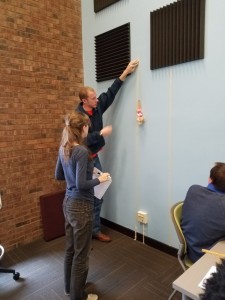
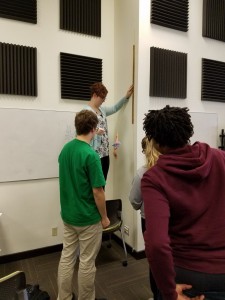
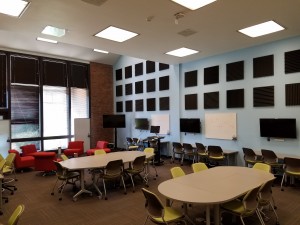
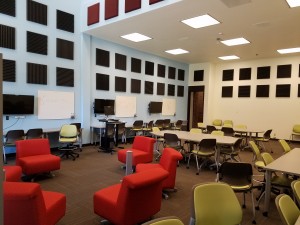
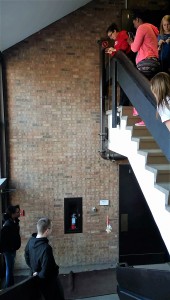 So, Barbie bungee jumping. I got the idea from an NCTM post. Tie linked rubber bands to Barbie’s feet. Do a few test runs with smaller amounts of rubber bands, create a line of best fit to model the drop distance, then use it to predict the number of rubber bands needed to drop Barbie from a second-story stair landing. The group that gets her closest to the floor without hitting her head wins. (Do post someone to warn passersby!)
So, Barbie bungee jumping. I got the idea from an NCTM post. Tie linked rubber bands to Barbie’s feet. Do a few test runs with smaller amounts of rubber bands, create a line of best fit to model the drop distance, then use it to predict the number of rubber bands needed to drop Barbie from a second-story stair landing. The group that gets her closest to the floor without hitting her head wins. (Do post someone to warn passersby!)